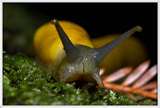|
|
How much do you know about your pet slug and its relatives?
If you score at least six correct you are a Mollusk Whiz!
1. Are slugs a member of the insect family?
A. Yes
B. No
2. All slugs have one thing in common and can be easily
distinguished by this feature. Which is it?
A. Stalks
B. No feet
C. Shell
D. Thick Skin
3. Slugs are:
A. All Female
B. All Male
C. Hermaphrodites
D. Either male or female
4. A slug's slime is used:
A. So they can walk up walls and on ceilings
B. To help slug move
C. A defense mechanism
D. All of the above
5. Slugs are active during the day (diurnal).
A. True
B. False
6. Some slugs have shells.
A. True
B. False
7. Why do slugs melt when exposed to salt?
A. They are allergic to it.
B. They don't melt when exposed to salt.
C. They are afraid of salt.
D. It poisons them.
8. Slugs live for?
A. 1 year
B. 5 years
C. 10 years
D. Don't know
9. Slugs eggs hatch?
A. After a few weeks.
B. When they want to.
C. After a few months.
D. After a few years.
10. How do slugs get into tiny cracks and crevices?
A. They stretch themselves up to twenty times their length
and squish themselves through.
B. They fold themselves up and squish through.
C. They temporarily shrink using their salt-phobic nature and
then go through.
D. They don't.

Answers:
1. Answer: B. No. Specifically, a slug is not an insect it
is in fact a Mollusk a member of the family Mollusca. It has
very little in common with what is generally referred to as
a bug.
2. Answer: A. Stalks. All slugs have stalks that sprout just
above their eyes and are used for sensing the environment
around them. Some sea slugs also have stalks that run along
their bottoms to augment their ability to sense their
environment and prey.
3. Answer: C. Hermaphrodites. Slugs have both male and
female organs and when they mate they impregnate each other
and both lay eggs a little later.
4. Answer: D. All of the above. Slugs use their slime trail
as their means of transportation. Not only can they use it
to climb walls and ceilings but they can also use it to
clearly mark a trail from one food source to another and the
slime trail will stay through the next day. It is said that
the slime is so viscous that a slug can crawl across the
edge of a knife and not hurt their fragile underbelly. They
also use it to protect themselves from predators. When a
predator catches them they create an even thicker slime that
makes it very difficult for whatever is trying to eat them
to actually swallow them, essentially choking their
attacker.
5. Answer: B. False. Slugs are actually nocturnal and often
hide away and rest during the day. They use the cover of
darkness to forage for food and hide from predators. If you
see a slug during the day it is rare and most likely the
only reason you see it is because it is looking for shelter.
Slugs prefer to rest under rocks, under logs, or under the
ground. The stay where it is cool and damp because the sun
dries them out.
6. Answer: A. True. Some slugs really do have shells that
are found at the base of the head under a layer of skin.
7. Answer: D. Salt reacts with the slug slime, making their
slime salty. This triggers an osmotic process across the
permeable membrane of their skin, drawing out the water that
makes up most of their bodies. They are essentially melting.
In order to balance the saltiness of their slime, water
rapidly leaves the cells of the snail dehydrating the snail
to death.
8. Answer: D. Don't know. Slugs live for a long time,
hibernating over the winter and are active during the warmer
seasons. Scientists have not actually documented exactly how
long a slug can live because they do not live long in
captivity and there hasn't been a way to tag one slug in the
wild in order to see just how long they live.
9. Answer: B. When they want to. Slug eggs will rest in the
ground until conditions are right for them to hatch and the
babies to emerge into the world. This is usually whenever
the environment is cool and damp, which could take a few
days or a few years. This makes them a very drought-
resistant species.
10. Answer: A. They stretch themselves up to twenty times
their length and squish themselves through. A slug's body is
very stretchy and they can literally go where you wouldn't
think they can get to by stretching themselves very thin and
flat, molding themselves into the crack using their slime
and pushing through to get to where they want to go.
More on Slugs
& Invertebrates
|